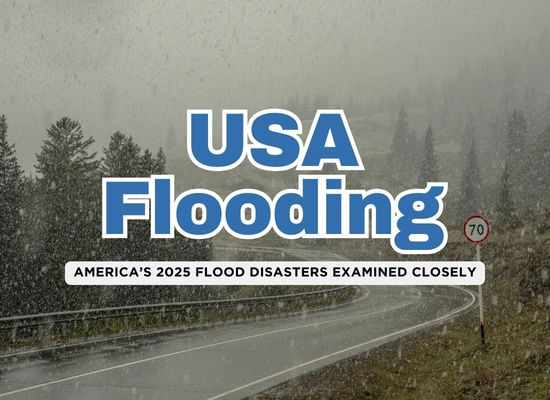The first months of 2025 have been anything but calm. From the mountain valleys of Kentucky to the storm-drenched plains of South Texas, record-breaking floods have disrupted lives, claimed homes, and left communities in turmoil. These weren’t just isolated weather events—they were the result of a changing climate, aging infrastructure, and gaps in preparation. In this deep dive, we’ll break down the three most devastating floods so far this year, examine what contributed to each disaster, and explore how better planning could help prevent the worst next time.
1️⃣ The Appalachian Torrent – February Floods Across Kentucky and Beyond
In mid-February 2025, a slow-moving storm system stalled over the Appalachian region, dumping relentless rain across Kentucky, West Virginia, Tennessee, and Virginia. What began as a forecasted rain event escalated into one of the worst flood disasters in recent memory.
🌧️ The Build-Up:
- Over 7 inches of rain fell within 48 hours across already saturated ground.
- Snowmelt from the surrounding highlands added to the volume, pushing river systems beyond capacity.
- The North Fork of the Kentucky River reached a historic crest, overwhelming levees and floodwalls.
🚨 What Went Wrong:
- Many flood-prone areas lacked updated hazard maps, leaving residents unaware they were at serious risk.
- Emergency communication systems were overloaded or delayed in rural areas, where evacuations often came too late.
- Critical infrastructure, including drainage systems and culverts, had not been upgraded in decades.
🔧 Steps That Could Have Helped:
- Modernized Floodplain Mapping: Accurate maps would have warned at-risk residents earlier and helped guide smarter land use planning.
- Investment in Rural Warning Systems: More robust alert systems, like text-based evacuation notices and sirens in remote valleys, could have saved lives.
- Improved Infrastructure Maintenance: Regular clearing of culverts, investment in stormwater management, and rebuilding vulnerable bridges and roads would have reduced damage.
🧭 The Aftermath:
- At least 14 people lost their lives in Kentucky alone.
- Thousands of homes were damaged or destroyed, many of them uninsured due to being outside of outdated flood zones.
- Local governments called for emergency funds and long-term federal infrastructure aid.
This flood served as a harsh reminder: even in areas that don’t typically make headlines, the combination of extreme weather and under-preparedness can be deadly.
2️⃣ The Drenched Borderlands – March Flooding in South Texas
On March 27, 2025, South Texas found itself at the mercy of a freak weather event. In just a matter of hours, the skies unleashed torrents of rain—over 21 inches in some towns—turning quiet neighborhoods and busy highways into raging rivers. Cities like Harlingen and McAllen were hit hardest, with widespread power outages, water rescues, and heartbreaking losses.
🌪️ What Sparked the Deluge:
- A stalled low-pressure system off the Gulf of Mexico pulled in warm, moisture-rich air, creating a conveyor belt of thunderstorms that wouldn’t move.
- The region’s flat terrain and clay-heavy soil couldn’t absorb the water fast enough, leading to rapid surface runoff.
- Drainage systems, already stressed by development and population growth, failed to keep up.
🚨 Where It Broke Down:
- Many neighborhoods were built without adequate flood planning, with older developments lacking retention ponds or proper elevation.
- Emergency crews were overwhelmed—rescue boats couldn’t reach all trapped residents in time.
- Communication gaps left many unaware of just how severe the storm would be. Flash flood warnings were issued, but some areas had only minutes to act.
💡 What Could Have Made a Difference:
- Urban Planning with Flooding in Mind: South Texas cities need stricter development rules in flood-prone zones, including elevation standards and water retention systems.
- Investment in Green Infrastructure: Swales, wetlands, and permeable pavement could have helped soak up rainfall naturally, easing the burden on sewers.
- Community-Based Preparedness Drills: With growing urban sprawl, local response plans need to be practiced and understood—especially in underserved neighborhoods where resources are thinner.
🌊 The Aftermath:
- At least 4 confirmed fatalities, dozens injured, and hundreds rescued by boat.
- Thousands of homes and businesses flooded, with initial damage estimates climbing into the hundreds of millions.
- A state of emergency was declared, and disaster declarations followed, but recovery will be slow—especially for low-income families without flood insurance.
This wasn’t just a storm. It was a warning siren for every city across the Gulf Coast: climate volatility is here, and our systems are still playing catch-up.
3️⃣ The Cross-Country Cascade – Late March Storms from the Plains to the Atlantic
At the end of March 2025, a powerful spring system swept across the central United States, bringing a destructive mix of tornadoes, severe thunderstorms, and flash floods. What made this storm different wasn’t just the speed or strength—it was the sheer size. The system moved like a bulldozer, stretching from Texas all the way into New York and the Carolinas. Five people lost their lives. Millions were affected.
⛈️ How It Unfolded:
- A deepening low-pressure system collided with warm, moist air from the Gulf and frigid air from the Rockies—an ideal recipe for violent storms.
- Supercells generated severe hail and tornadoes across Oklahoma, Missouri, and Arkansas.
- As the storm pushed east, it dropped inches of rain in hours across saturated ground in the Southeast and Mid-Atlantic.
⚠️ Why the Flooding Was So Widespread:
- The storm covered a huge area, hitting places that had already received above-average rainfall earlier in March.
- Many rivers were already running high, and drainage systems—especially in older cities like Baltimore and Richmond—were overwhelmed quickly.
- In urban areas, paved surfaces meant little absorption, turning streets into flood channels within minutes.
🔍 What Could Have Been Done Better:
- Proactive Reservoir Management: In some areas, dams and levees weren’t preemptively relieved, which could have created more room for runoff.
- Urban Retrofits: Cities still reliant on 20th-century stormwater systems should be modernizing with dual-drainage approaches—handling both normal flow and extreme surges.
- Regional Forecast Coordination: Some regions saw conflicting forecasts. More unified communication between federal and local weather services could improve clarity in fast-moving events.
💥 The Fallout:
- Flash flooding trapped drivers in underpasses and washed out major roads, including parts of I-95.
- Airports in Atlanta, Charlotte, and D.C. saw massive delays and cancellations due to both wind and flooding.
- Power outages affected over 600,000 customers across five states, many for multiple days.
This storm underscored a truth that’s becoming harder to ignore: floods don’t need a named hurricane to devastate. When the ground is soaked and the clouds won’t move, floodwaters rise fast—sometimes faster than our cities and systems can handle.
The floods of early 2025 weren’t isolated events—they were symptoms of a much larger trend. As the climate shifts and rainfall patterns become more extreme, the old playbooks no longer work. Communities that once flooded every few decades are now seeing water in their streets every few years. And for many, the next flood won’t wait.
But this isn’t just a story of loss. It’s a wake-up call—and an opportunity. We have the tools to build smarter cities, implement better emergency systems, and protect those most vulnerable. Whether it’s investing in green infrastructure, updating outdated flood maps, or ensuring local families know what to do when storms roll in, every action counts.
Floods don’t care about borders. But how we prepare—and how we respond—will decide whether we’re just reacting to disasters… or building a future that can weather them.


